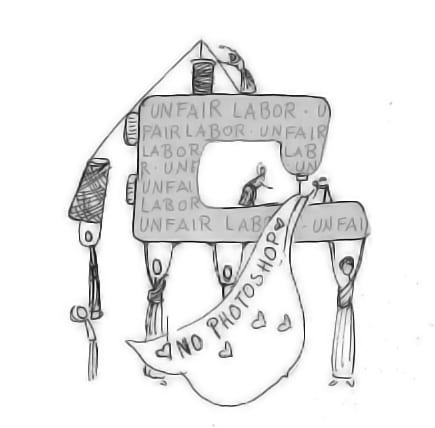It’s taken decades of outraged, desperate pleas from countless people alienated by the fashion industry, but mainstream brands are finally starting to feature some progressive read: normal imagery. This year, American Eagle’s lingerie brand, Aerie, made the bold move to showcase un-Photoshopped models. The surge of appreciation via social media was a testament to our immense relief after so many years of frustration.
Last spring, mega-brand H&M incorporated plus-size model Jennie Runk into their beachwear campaign without labelling her or her outfits “plus-size.” Few companies would allow a larger model to casually coexist with the size 0s we’re all accustomed to seeing in advertisements, but H&M sensed the sea change in consumer tastes. Jennie Runk’s swimsuit photoshoot was a major leap toward normalizing women with a bit of a belly.
Both of these moves left me ecstatic – for about two minutes. I wish I could take them at face value and rejoice in their promise of increased inclusivity, but the truth is that these are shallow distractions.
Neither of these companies are interested in justice of any kind. I don’t just mean that they’re trying to generate buzz in order to ramp up profits; that’s part of it, certainly, but par for the course in retail culture. The real trouble is that their efforts to appear altruistic in the public eye distance us from the brutal realities of their labor practices. Both Aerie and H&M are two of the worst offenders in terms of underpaying factory workers and accepting horrifically low standards for their working conditions.
Aerie’s parent company, American Eagle Outfitters, outsources garment manufacture to Dhaka, Bangladesh. If the city sounds familiar, that’s probably because in 2013 it bore witness to the deadliest garment-factory accident in history. The Rana Plaza building was known to be unsafe, but its garment workers were ordered to show up anyway, with tragic consequences. The deaths of 1,129 people haunt the city, but this disaster wasn’t enough to prompt substantive change.
Indeed, American Eagle Outfitters signed an accord binding them to raise standards for factory conditions and compensate survivors and affected parties. Lo and behold, six months later, the International Labor Rights Forum reported that “very little compensation from the negligent parties … has reached the survivors and the families of the deceased.” Clearly, American Eagle Outfitters has trivialized the suffering caused by this unregulated sweatshop labor, even after signing an accord claiming the contrary.
H&M is actually the biggest patron of Bangladeshi sweatshops. To their credit, they didn’t do business with the Rana Plaza location. Still, their status as an industry giant renders them a major player in global labor rights. Rather than using their considerable influence to call for tangible change, they reinforce the existing system – characterized by starvation wages, long hours, unsafe factories and even child labor – with their multinational business. If you ever wondered how H&M can afford to price their T-shirts at five dollars and their jeans at 15 dollars, this might be a clue.
In November, H&M released a statement that they would commit to raising factory worker wages, even if it means bumping up clothing prices. Great! However, an increase from practically nothing to slightly-more-than-practically-nothing does not establish a benchmark for a living wage. Relative improvement in this business means very little.
So what does this all mean for an American woman who is overjoyed to see models who look slightly more like her? We can credit the progress in that particular arena, but we have to understand that our bodies are not the only bodies that suffer in this system. Body image issues are incredibly important, but no more important than the dehumanizing labor endured by garment factory workers. We need to recognize when “inclusivity” is exclusive – to the people we don’t see, whose labor structures our lives.
Abby Grosse ’15 [email protected] is from Shoreview, Minn. She majors in English with concentrations in media studies and women’s and gender studies.
Graphic Credit: ALLI LIVINGSTON/MANITOU MESSENGER



